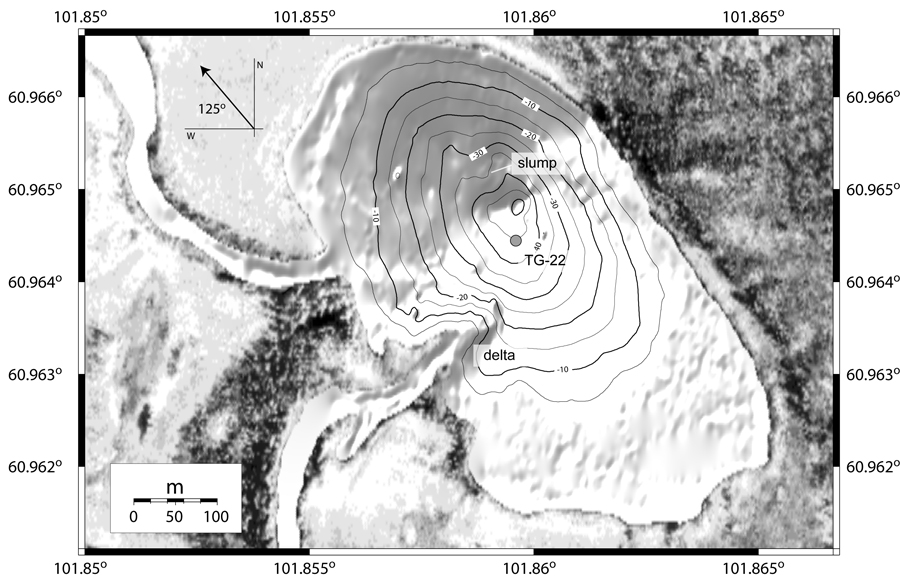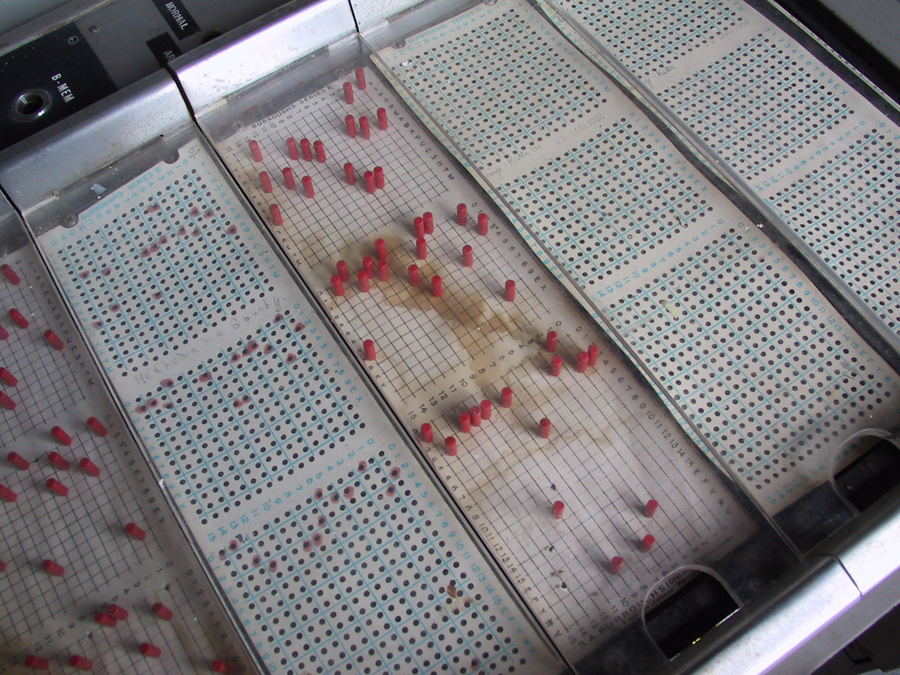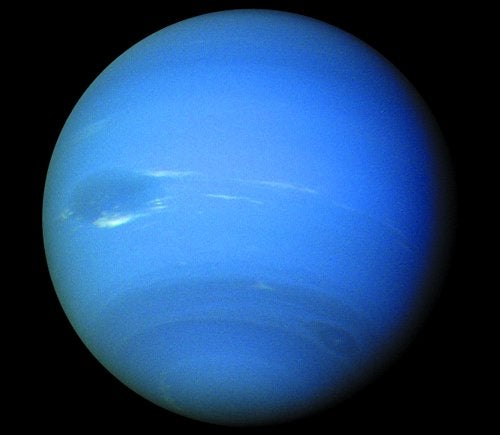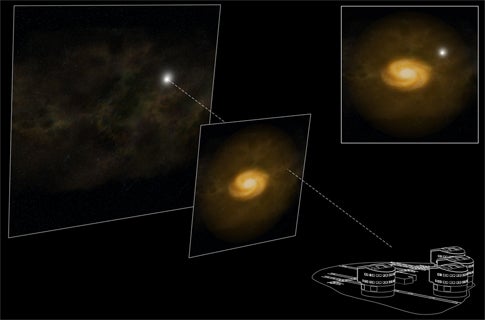The standard version of the “Tunguska event” goes like this: A small asteroid or comet fragment entered Earth’s atmosphere June 30, 1908, over Siberia. It exploded from the heat of reentry before reaching the ground, flattening some 770 square miles (2,000 square kilometers) of forest near the Tunguska River.
A team led by physicist Giuseppe Longo of the University of Bologna, Italy, thinks there may be more to it. In an article published online June 15 in Terra Nova, the scientists report evidence that a chunk of the exploding object broke off and struck the ground 5 miles (8 km) northwest of the explosion’s epicenter, carving out today’s Lake Cheko.
Lake Cheko is an oblong freshwater lake about 1,340 feet (410 meters) on its long axis. No detailed maps of the remote region exist younger than 1928, so there is no simple way to establish whether Lake Cheko existed before the 1908 Tunguska event. The main evidence right now centers on the lake’s underwater contours. The researchers say the lake, although shallow, has the right bathymetry to be an impact crater – its shaped like a funnel instead of a gently sloping basin, like other lakes in the area. Lake Cheko is about 160 feet (50m) at maximum depth.
Also, geophysical mapping of the lake bottom revealed a dense region 33 feet (10m) below the lakebed sediment that could be a fragment of the object, or perhaps sediment compacted by the impact.
The lake is unlike classic impact craters in some ways. For example, it is elliptical in shape (most impact craters are round) and no blanket of debris is visible around its rim. The Italian team says these features can be explained if the fragment was relatively small (less than 33 feet [10m] across); if it were traveling at less than 23,000 mph (36,000 kph), or half the speed of most meteors; and if it landed in waterlogged, swampy forest underlain by permafrost. After impact, melting and degassing of the permafrost could have created today’s lima-bean-shaped Lake Cheko.
Harder evidence is needed to convince other scientists, however. Following expeditions to the site in 1999 and 2002, the team hopes to return in 2008 to collect sample cores of the lake bottom and, they hope, unearth a chunk of the infamous Tunguska object.
Titan: the new Earth?
Phil Harrington’s binocular universe (November 2007 online extra)
Lemaître, the calculator
Georges Lemaître was passionate about numerical calculation and gravitated toward powerful machines for carrying it out. Late in his career, as he began offloading some of his teaching responsibilities at the Catholic University at Louvain (UCL), he became increasingly absorbed by calculation.
Using electromechanical machines, Lemaître computed the frequencies and vibration modes of the monodeuteroethylene molecule as part of project headed by Hugh Taylor, a chemist at Princeton University. In 1958, Lemaître introduced and programmed UCL’s first electronic computer – a Burroughs E 101.
This was not a desktop computer, but a desk-sized computer designed for bookkeeping. It had punched paper-tape input, 160 vacuum tubes, 1,800 diodes, and about 2 kilobytes of memory. Today, there’s thousands of times more computing power in a low-end cell phone. But, in its day, the E 101 and machines like it were the top dogs of numerical computing.
In 2006, UCL’s High-Performance Computing and Mass Storage Institute acquired a new 300-processor Beowulf computer cluster. Not surprisingly, the group dubbed its powerful new hardware “Lemaître.”
Tough questions for your prospective eye surgeon
NASA finds martian cave skylights
NASA’s Mars Odyssey spacecraft has discovered entrances to seven possible caves on the slopes of a martian volcano. The find is fueling interest in potential underground habitats and sparking searches for caverns elsewhere on the Red Planet.
Very dark, nearly circular features ranging in diameter from about 328 to 820 feet puzzled researchers who found them in images taken by NASA’s Mars Odyssey and Mars Global Surveyor orbiters. Using Mars Odyssey’s infrared camera to check the daytime and nighttime temperatures of the circles, scientists concluded that they could be windows into underground spaces.
Evidence that the holes may be openings to cavernous spaces comes from the temperature differences detected from infrared images taken in the afternoon and in the pre-dawn morning. From day to night, temperatures of the holes change only about one-third as much as the change in temperature of surrounding ground surface.
“They are cooler than the surrounding surface in the day and warmer at night,” said Glen Cushing of the U.S. Geological Survey’s Astrogeology Team and of Northern Arizona University, Flagstaff, Arizona. “Their thermal behavior is not as steady as large caves on Earth that often maintain a fairly constant temperature, but it is consistent with these being deep holes in the ground.”
A report of the discovery of the possible cave skylights by Cushing and his co-authors was published online recently by the journal Geophysical Research Letters.
“Whether these are just deep vertical shafts or openings into spacious caverns, they are entries to the subsurface of Mars,” said co-author Tim Titus of the U.S. Geological Survey in Flagstaff. “Somewhere on Mars, caves might provide a protected niche for past or current life, or shelter for humans in the future.”
The discovered holes, dubbed “Seven Sisters,” are at some of the highest altitudes on the planet, on a volcano named Arsia Mons near Mars’ tallest mountain.
“These are at such extreme altitude, they are poor candidates either for use as human habitation or for having microbial life,” Cushing said. “Even if life has ever existed on Mars, it may not have migrated to this height.”
The new report proposes that the deep holes on Arsia Mons probably formed as underground stresses around the volcano caused spreading and faults that opened spaces beneath the surface. Some of the holes are in line with strings of bowl-shaped pits where surface material has apparently collapsed to fill the gap created by a linear fault.
The observations have prompted researchers using Mars Odyssey and NASA’s newer Mars Reconnaissance Orbiter to examine the Seven Sisters. The goal is to find other openings to underground spaces at lower elevations that are more accessible to future missions to Mars.
“The key to finding these was looking for temperature anomalies at night — warm spots,” said Phil Christensen of Arizona State University, Tempe, principal investigator for the Thermal Emission Imaging System on Mars Odyssey. That instrument produced both visible-light and infrared images researchers used for examining the possible caves.
“No other instrument at Mars could give the thermal information crucial to this research,” said the project scientist for Mars Odyssey, Jeffrey Plaut of NASA’s Jet Propulsion Laboratory, Pasadena, California. “This is a great example of the exciting discoveries Odyssey continues to make.” Mars Odyssey reached Mars in 2001, years before any of the other spacecraft currently examining the planet. Its predecessor, Mars Global Surveyor, ended its mission last year.
Presto change-o!
An animated look at black-hole spin
Astronomy magazine podcast: Amateur Telescope Makers of Boston
In this new series, we’ll visit with astronomy clubs from around the world.
The Amateur Telescope Makers of Boston (ATMoB) traces its roots back to the 1930s. In 1973, the Bond Astronomical Society, another long-standing club, merged with ATMoB, making one of the oldest and largest general-interest astronomy clubs in the United States.
In this week’s show, Virginia Renehan, president of ATMoB, discusses her club’s activities and the art of telescope making.
After you listen, please e-mail us here and let us know what you think.
To subscribe to our podcast, click here.
Canon’s image-stabilized binoculars
Neptune’s warm south pole
An international team of astronomers has discovered that Neptune’s south pole is much hotter than the rest of the planet. They have published the first temperature maps of the lowest portion of Neptune’s atmosphere, which show that this warm south pole is providing an avenue for methane to escape out of the deep atmosphere.
“The temperatures are so high that methane gas, which should be frozen out in the upper part of Neptune’s atmosphere, the stratosphere, can leak out through this region,” said Glenn Orton of NASA’s Jet Propulsion Laboratory, Pasadena, California. Orton is lead author of a paper appearing in the September 18 issue of the journal Astronomy and Astrophysics. These findings were made using the Very Large Telescope, located in Chile, operated by the European Organization for Astronomical Research in the Southern Hemisphere (known as ESO).
In the paper, Orton and his colleagues report that the temperature at Neptune’s south pole is hotter than anywhere else on the planet by about 10 degrees Celsius (18 degrees Fahrenheit). The average temperature on Neptune is about –200 degrees Celsius (–392 degrees Fahrenheit).
Neptune, the farthest known planet of our solar system, is located about 30 times farther away from the Sun than Earth is. Only about one thousandth of the sunlight received by our planet reaches Neptune. Yet, the small amount of sunlight Neptune does receive significantly affects the planet’s atmosphere.
The astronomers found that these temperature variations are consistent with seasonal changes. A Neptunian year lasts about 165 Earth years. It has been summer in the south pole of Neptune for about 40 years now, and they predict that as winter turns to summer at the north pole, an abundance of methane would leak out of a warm north pole in about 80 years.
“Neptune’s south pole is currently tilted toward the Sun, just as the Earth’s south pole is tilted toward sun during summer in the southern hemisphere,” explains Orton. “But on Neptune the Antarctic summer lasts 40 years instead of a few months, and a lot of solar energy input during that time can make big temperature differences between the regions in continual sunlight and those with day-night variations. This is a likely factor in Neptune having the strongest winds of any planet in the solar system; sometimes, the wind blows there at more than 2,000 kilometers per hour,” said Orton.
The new observations also reveal mysterious high-latitude “hot spots” in the stratosphere that have no immediate analogue in other planetary atmospheres. The astronomers think this feature was generated by upwelling gas from much deeper in the atmosphere.
Methane is not the primary constituent of Neptune’s atmosphere, which, as a giant planet, is mostly composed of the light gases, hydrogen and helium. But it is the methane in Neptune’s upper atmosphere that absorbs the red light from the sun and reflects the blue light from the sun back into space, making Neptune appear blue.
The new results were obtained with the Very Large Telescope and spectrometer for the mid-infrared, operated by the European Organization for Astronomical Research in the Southern Hemisphere (known as ESO).
Galaxy hunting made easy
Astronomers using ESO’s Very Large Telescope have discovered in a single pass about a dozen otherwise invisible galaxies halfway across the universe. The discovery, based on a technique that exploits a first-class instrument, represents a major breakthrough in the field of galaxy ‘hunting’.
The team of astronomers led by Nicolas Bouche has used quasars to find these galaxies. Quasars are very distant objects of extreme brilliance, which are used as cosmic beacons that reveal galaxies lying between the quasar and us. The galaxy’s presence is revealed by a ‘dip’ in the spectrum of the quasar — caused by the absorption of light at a specific wavelength.
The team used huge catalogues of quasars, the so-called SDSS and 2QZ catalogues, to select quasars with dips. The next step was then to observe the patches of the sky around these quasars in search for the foreground galaxies from the time the Universe was about 6 billion years old, almost half of its current age.
“The difficulty in actually spotting and seeing these galaxies stems from the fact that the glare of the quasar is too strong compared to the dim light of the galaxy,” says Bouche.
This is where observations taken with SINFONI on ESO’s VLT made the difference. SINFONI is an infrared ‘integral field spectrometer’ that simultaneously delivers very sharp images and highly resolved color information (spectra) of an object on the sky.
With this special technique, which untangles the light of the galaxy from the quasar light, the team detected 14 galaxies out of the 20 pre-selected quasar patches of sky, a hefty 70% success rate.
“This high detection rate alone is a very exciting result,” says Bouche. “But, these are not just ordinary galaxies: they are most notable ones, actively forming a lot of new stars and qualifying as ‘starburst galaxies’.”
“We discovered that the galaxies located near the quasar sightlines are forming stars at a prodigious rate, equivalent to 20 suns per year,” adds team member Celine Peroux.
These findings represent a big leap forward in the field, setting the stage for a very promising era of galaxy ‘hunting’.
The astronomers now plan to use SINFONI to study in more detail each of these galaxies, by measuring their internal motions.









